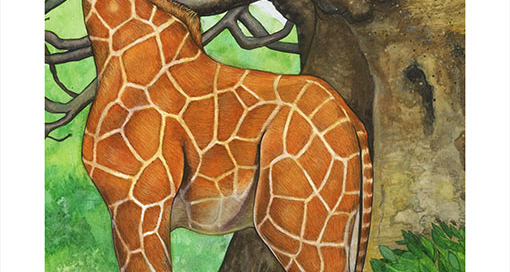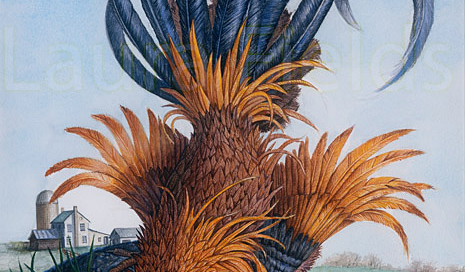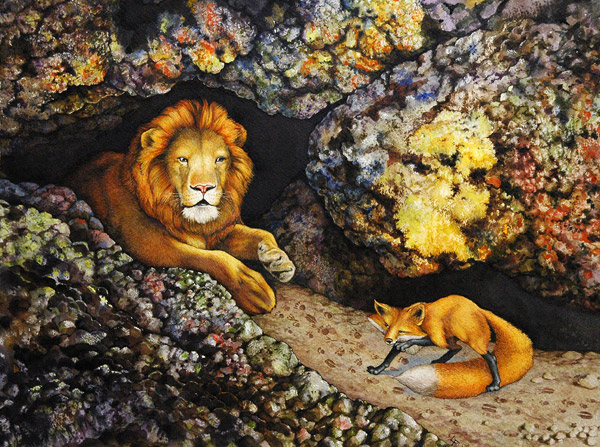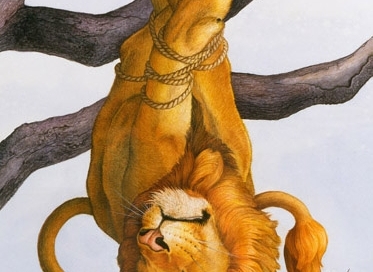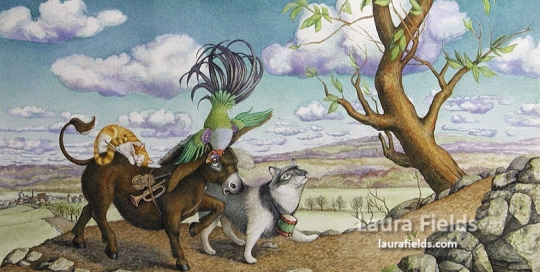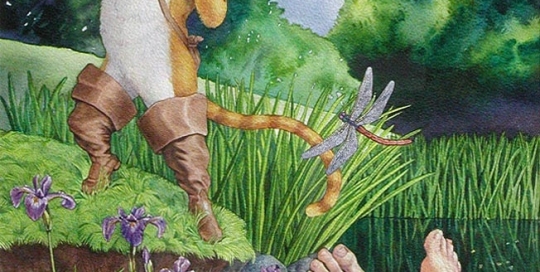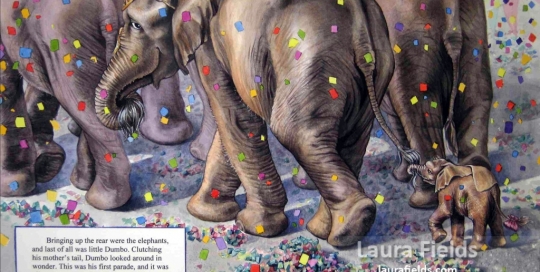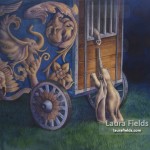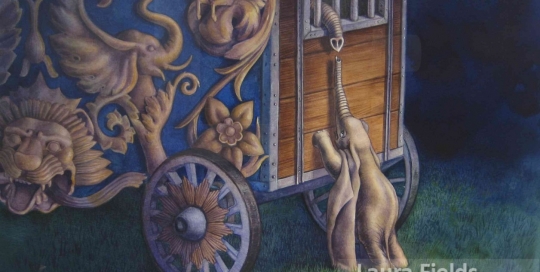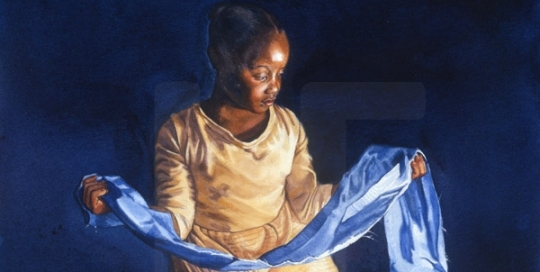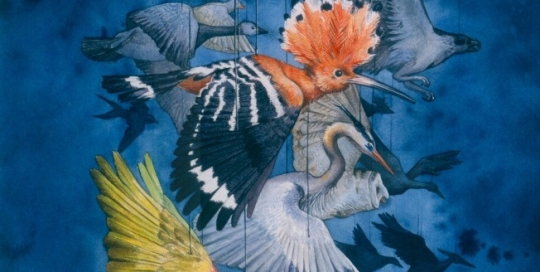Aesop’s The Rooster and the Jewel
Childrens Books and Stories, Illustrations, Watercolors
Aesop’s The Rooster and the Jewel
cock, scratching the ground for something to eat, turned up a jewel that had once been dropped there. “Ho”, said he, “a fine thing you are, no doubt, and, had your owner found you, great would his joy have been. But for me, give me a single grain of corn before all the jewels in the world.”
This Aesop’s fable, though more popularly illustrated and told in medieval Europe, hit a cord in me. I find the theme very thought provoking and applicable to a modern audience. What one may find important, others may not. A modern ideal may be to find oneself surrounded by all one’s favorite things or pine for the things one wants, when the truth may be that those things that are truly needed are forgotten or overlooked. Even the cocky rooster on the dunghill seems to know that worth is not determined by how badly something is desired, but by how much it is needed.
 The painting is purely watercolor painted with both wet and “drybrush” technique. It is one half of a diptych, the other being Aesop’s Lion and the Mouse. The two are meant to hang vertically with the Rooster on the left and the Lion on the right. The color schemes are purposefully linked.
The painting is purely watercolor painted with both wet and “drybrush” technique. It is one half of a diptych, the other being Aesop’s Lion and the Mouse. The two are meant to hang vertically with the Rooster on the left and the Lion on the right. The color schemes are purposefully linked.
Watercolor on Windsor Newton cold press (signed and numbered prints available)
Aesop’s the Lion and the Fox
Childrens Books and Stories, Illustrations, Watercolors
lion that had grown too old and weak to hunt pretended to be sick as a ruse to make the other animals come and pay their respects. When they did so, he ate them one by one. The fox also came to see him but greeted him from outside the cave. When the lion asked the fox why he did not come in the cave to visit, the fox replied, “Because I can only see the tracks going in, but none coming out.”
I have always found the morality tales that involve foxes very interesting. Foxes have been made to be sly and clever, but also arrogant or foolhardy. Applying anthropomorphic traits to the fox allows the reader to judge humanity and its less than honorable traits without judging oneself or others too harshly. The fox has become a common stand in for conniving and deceitful characters, but can also represent a cunning and calculating persona. He is a reliable character to illustrate because of all the traits that we have come to assume the fox possesses.
Here, the fox is wary of the danger that the lion presents to him. He knows that it is easier to avoid the danger than it is to get out of its grip. Sometimes weighing the costs of a decision and evaluating your options is in your best interest.
This painting is entirely done with watercolors. I used both wet and “drybrush” techniques and applied the use of salt in the creation of starburst patterns in the lichen on the stones.
Aesop’s the Lion and the Mouse
Childrens Books and Stories, Illustrations, Watercolors
nce when a Lion was asleep a little Mouse began running up and down upon him; this soon wakened the Lion, who placed his huge paw upon him, and opened his big jaws to swallow him. “Pardon, O King,” cried the little Mouse: “forgive me this time, I shall never forget it: who knows but what I may be able to do you a turn some of these days?” The Lion was so tickled at the idea of the Mouse being able to help him, that he lifted up his paw and let him go. Some time after the Lion was caught in a trap, and the hunters who desired to carry him alive to the King, tied him to a tree while they went in search of a wagon to carry him on. Just then the little Mouse happened to pass by, and seeing the sad plight in which the Lion was, went up to him and soon gnawed away the ropes that bound the King of the Beasts. “Was I not right?” said the little Mouse.
Little friends may prove great friends.
This fable is immediately recognizable to any fan of Aesop. The great lion is forced to ask for help from the smallest of creatures. It forces us to confront our own preconceived notions of who or what is weak or powerful. Great strength comes in unexpected places and from unexpected people, and we shouldn’t be so quick to decide how we expect to receive either. I have always appreciated the story and love the idea that greatness and kindness can be found within us all.
This painting is purely watercolor. I used both wet and “drybrush” technique. […]
The Musicians of Bremen
Childrens Books and Stories, Illustrations, Watercolors
he Musicians of Bremen is the story of a donkey, a dog, a cat, and a rooster, all past their prime years in life and usefulness on their respective farms, were soon to be discarded or mistreated by their masters. One by one they leave their homes and set out together. They decide to go to Bremen, known for its freedom, to live without owners and become musicians there. (“Something better than death we can find anywhere.”)
This illustration is of a hopeful moment in which the foursome make their way down the road toward their fortune, leaving their pasts behind them. I have always loved this story. The themes of fighting back against the drudgery of daily life that ages us all and strength in unity carry weight and reinforce the need in all of us to never give up. Children read in this story that a difficult task can be made easier with the support and help of others that care about you. Stories that teach and motivate have always inspired me.
Watercolor on Windsor Newton cold press (signed and numbered prints available)
Puss in Boots
Childrens Books and Stories, Illustrations, Watercolors
” you will follow my advice your fortune is made. You have nothing else to do but go and wash yourself in the river, in that part I shall show you, and leave the rest to me.”
The Marquis of Carabas did what the Cat advised him to, without knowing why or wherefore. While he was washing the King passed by, and the Cat began to cry out:
“Help! help! My Lord Marquis of Carabas is going to be drowned.”
At this noise the King put his head out of the coach- window, and, finding it was the Cat who had so often brought him such good game, he commanded his guards to run immediately to the assistance of his Lordship the Marquis of Carabas. While they were drawing the poor Marquis out of the river, the Cat came up to the coach and told the King that, while his master was washing, there came by some rogues, who went off with his clothes, though he had cried out: “Thieves! thieves!” several times, as loud as he could.
“Master Cat; or, The Booted Cat” (early French: Le Maître Chat, ou Le Chat Botté), commonly known as “Puss in Boots”, is a French literary fairy tale about a cat who uses trickery and deceit to gain power, wealth, and the hand of a princess in marriage for his penniless and low-born master. The tale was written at the close of the seventeenth century by Charles Perrault (1628–1703), a retired civil servant and member of the Académie française. The tale appeared in a handwritten and illustrated manuscript two years before its 1697 publication by Barbin in a collection of eight fairy tales by […]
Dumbo on Parade
Childrens Books and Stories, Illustrations, Watercolors
ringing up the rear were the elephants and last was the smallest of all them. Clutching his mother’s tail, Dumbo looked around in wonder. This was his first parade and it was all exciting. He dreamed of the day when he would be the head of the procession.
This painting was done entirely with watercolor. Masking fluid was used to create the confetti that falls in the foreground. It is one of two paintings from the Dumbo series available for sale.
Watercolor on Windsor Newton cold press (signed and numbered prints available)
Dumbo’s Mother
Childrens Books and Stories, Illustrations, Watercolors
A young large-eared elephant reaches his trunk into the back of circus car to touch his mother’s trunk.
This part of the “Dumbo” story has always seemed the most poignant. Dumbo’s mother is caged for spanking a bully that was pulling little Dumbo’s ears, and is called a mad elephant. She was chained and caged in a circus car for a simple misunderstanding. In the image I chose to portray, she reaches for her son to comfort him. The image of a mother’s love for her son during difficult times is a timeless and universal theme we can all appreciate.
Watercolor on Windsor Newton cold press (signed and numbered prints available)
Sky Sash So Blue
Childrens Books and Stories, Illustrations, Watercolors
ords and artwork play off of one another like musical riffs in this story of one family who transforms fabric scraps into art and whose bonds of love are stronger than the chains of slavery. Readers may well suspect that Hathorn (Grandma’s Shoes) conceived her eloquent, rhyming narrative poem in tandem with Andrews, who crafts dramatic tableaulike paintings with accents made of canvas and cut paper. Susannah, a young slave girl, treasures a “sash of pale blue, made of pieces of sky” stitched and given to her by her mother.
This painting was done entirely with watercolor. The paint was applied very heavily in the sky to create an almost opaque blue background that sets the little girl in the space. This piece is privately owned.
Watercolor on Windsor Newton cold press (Not for sale)
The Conference of the Birds
Childrens Books and Stories, Illustrations, Watercolors
The Conference of the Birds, or The Speech of the Birds (Persian: منطق الطیر, Manṭiq-uṭ-Ṭayr, also known as مقامات الطیور Maqāmāt-uṭ-Ṭuyūr; 1177), is an epic of approximately 4500 lines written in Persian by the poet Farid ud-Din Attar, who is commonly known as Attar of Nishapur.
In the poem, the birds of the world gather to decide who is to be their king, as they have none. The hoopoe, the wisest of them all, suggests that they should find the legendary Simorgh, a mythical Persian bird roughly equivalent to the western phoenix. The hoopoe leads the birds, each of whom represent a human fault which prevents man from attaining enlightenment. When the group of thirty birds finally reach the dwelling place of the Simorgh, all they find is a lake in which they see their own reflection.
This painting was created as an advertisement for a play in Philadelphia. All of the bird charcters from the play are represented with the hoopoe, the wisest of them all at the center. The strings represent their being guided by outside forces and opinions other than their own on their route to self discovery.
Water color on Windsor Newton coldpress paper. (prints available)

